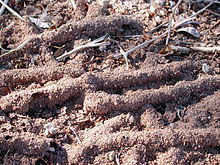Amitermitinae
| Amitermitinae Temporal range: Late Triassic–Recent |
|
|---|---|
 |
|
| Dry twigs covered with soil by feeding activities of encrusting termites, Gnathamitermis perplexus in the Sonoran Desert, Arizona | |
| Scientific classification | |
| Kingdom: | Animalia |
| Phylum: | Arthropoda |
| Class: | Insecta |
| Order: | Blattodea |
| Infraorder: | Isoptera |
| Family: | Rhinotermitidae |
| Subfamily: |
Amitermitinae Kemner, 1934 |
| genera | |
|
Ahamitermes |
|
Ahamitermes
Amitermes
Amphidotermes
Cephalotermes
Coptotermes
Cylindrotermes
Drepanotermes
Eremotermes
Globitermes
Gnathamitermes
Incolitermes
Invasitermes
Labritermes
Microcerotermes
Orientotermes
Prohamitermes
Pseudhamitermes
Pseudomicrotermes
Synhamitermes
Amitermitinae is a disputed subfamily of harvester termites and allies (family Termitidae) in the Isoptera infraorder. The subfamily is sometimes merged with the subfamily Termitinae and is considered by ITIS as an synonym.
Amitermitinae consists of 18 genera and 296 species. They have as typical characteristics a usually rounded head and a bilobed clypeus. The mandibles of their soldiers have usually a single median tooth.
They have evolved the ability to have many reproductives in their colony, up to a hundred, which allows very large colonies. As with other members of their Termitidae family, they have lost most of their cellulose-digesting protozoa. Instead, they digest fungi, which digest the cellulose and other organic matter. As a result, the Termitidae can make use of a wide variety of foods; not only rotten wood, but also grass, seeds, dung, soil, and detritus are all used by one species or another. In addition, some species can synthesize nitrogen compounds.
Many members of the Amitermitinae have evolved a very effective way of securing food. The Amitermes genera especially build a shell of earth by cementing the earth with their saliva and use it to cover vegetation. This smothers the plant and they can then eat the fungi that grow in the safety of the covering. They probably evolved in savanna, monsoon, and desert regions because their runways are not very resistant to rain erosion They use saliva to build runways, and this is an adaptation of an earlier use of saliva to entangle enemies
...
Wikipedia
